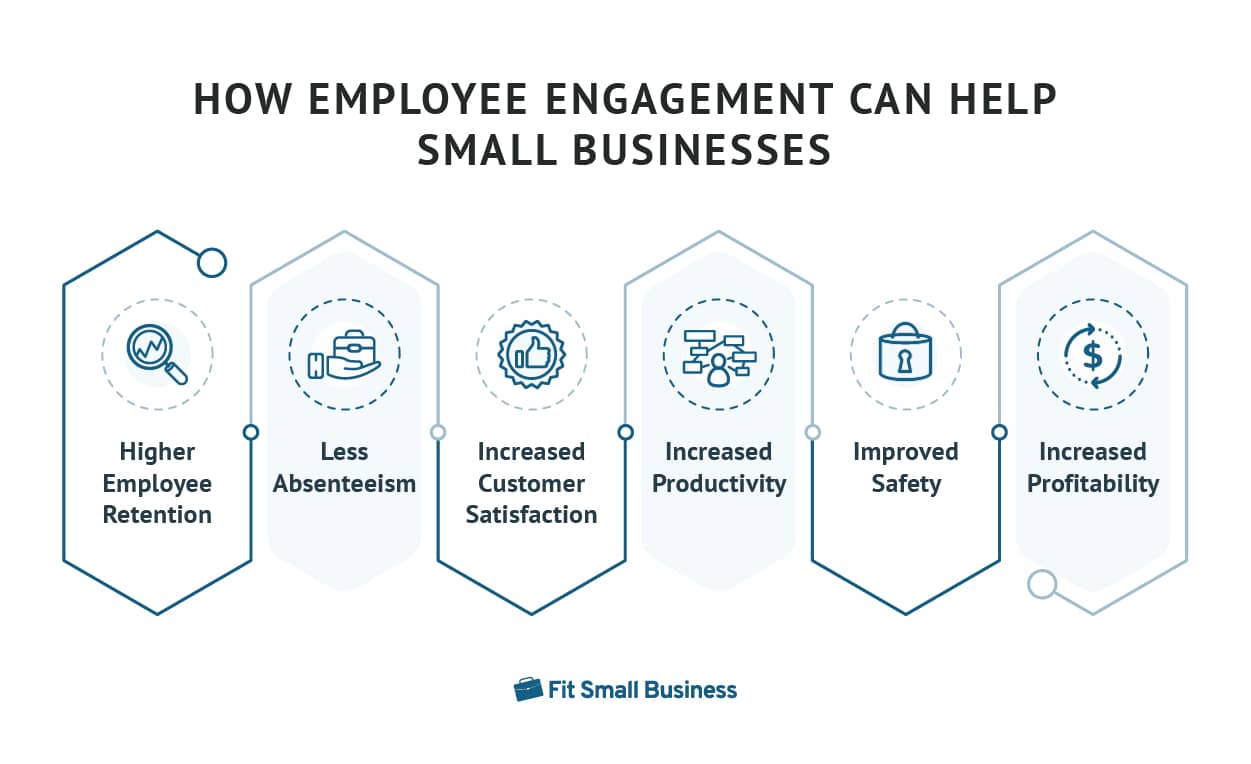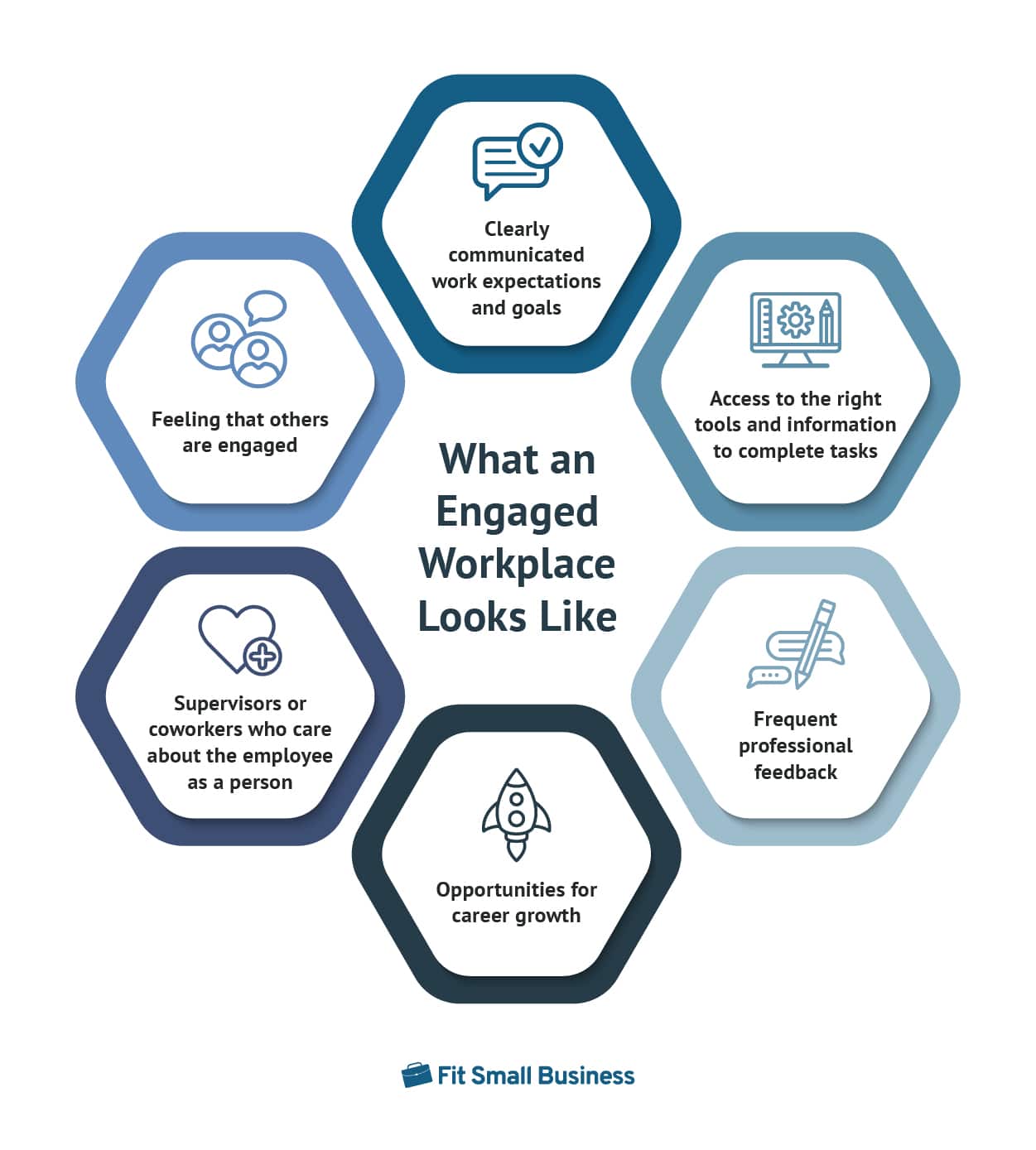Employee engagement describes the level at which an employee is connected to their work and the organization. Having high engagement with employees results in reduced turnover, improved productivity and work performance, and increased overall profitability. To keep employees engaged, small businesses can implement strategies like regular feedback sessions, recognizing and rewarding contributions, and fostering a culture of open communication and transparency.
Read on to learn more about what employee engagement is and why it’s important to small businesses.
Key Takeaways:
- Everything your business does impacts employee engagement, which in turn impacts everything your business does.
- Engaged workers are your company’s cheerleaders, both for new hires and for your customers and clients.
- Small immediate changes can make an impact on engagement—but it takes constant improvement and monitoring to keep engagement levels up.
Qualities of an Engaged Workplace
An engaged workplace is one where employees are glad to come to work, focus on their projects, offer suggestions for improvements, and speak well of their company to people outside of work. Organizationally, businesses support employees in their immediate work goals and longer-term careers and create an atmosphere of trust and communication. When employees are in an engaged workplace, they show a deep connection to their work—showcasing enthusiasm and dedication when handling their jobs.
Specifically, highly engaged workplaces have these qualities:
- Clearly communicated work expectations and goals: Understanding expectations and objectives ensures everyone is aligned and moving in the same direction. This serves to boost engagement by providing clarity and purpose in daily tasks.
- Access to the right tools and information to complete tasks: Providing necessary resources empowers employees to perform their duties efficiently. This not only improves productivity but also boosts morale and engagement by removing unnecessary barriers to task completion.
- Frequent professional feedback: Constructive feedback is key to professional development. Regular feedback ensures employees are aware of their progress and areas for improvement, engaging them further through the pursuit of personal and professional growth.
- Opportunities for career growth: Engaged employees are more productive and work harder—and are consequently rewarded for their efforts. This gives leeway for professional development and advancement, which in itself is an incentive for employees to keep striving. With a clear goal for the company in mind, as well as a goal for themselves, engaged employees can look forward to their work each day.
- Supervisors or co-workers who care about the employee as a person: Genuine care and concern for employees contribute significantly to their sense of belonging and engagement. Personal connections in the workplace ensure a supportive and collaborative environment.
- Feeling that others are engaged: When employees see that their peers are engaged, they start feeling optimistic and positive. Optimism is contagious. A positive attitude fosters a constructive and energizing work atmosphere, encouraging employees to engage deeply with their work and the company’s mission.
Beyond what can be seen in interpersonal interactions and organizational displays, engaged workplaces have employees who:
- Believe that their job is important to the mission of the organization: When employees see the value of their work in the broader company mission, it fosters a sense of importance and motivation. This connection enhances engagement, as individuals feel their contributions are significant and impactful.
- Have a sense of fulfillment: Feeling fulfilled at work goes beyond completing tasks. It involves a sense of accomplishment and purpose, driving engagement by making work more meaningful and rewarding for employees.
- Give recognition or praise for doing a good job: Recognition validates effort and achievements, making all employees feel valued across the board. This positive reinforcement encourages continued excellence and significantly boosts engagement levels.
- Value employee opinions: When employees feel heard, they feel respected. Encouraging input and valuing opinions foster a culture of trust and respect, essential components for deepening worker engagement.
Benefits of Employee Engagement
Employee engagement is important for small businesses for many reasons—it can impact everything from employee retention and safety to customer satisfaction and company profitability.

- Higher employee retention: Engaged employees have less reason to leave a company because they feel not only invested in the goals of the company but valued as an employee and person. They see opportunities in the company and believe in the company’s purpose. Check our recommended strategies for employee retention for more ideas on how to keep employees within your company.
- Less absenteeism: In an engaged workplace, employees are more likely to show up for work and take fewer personal days because they are motivated and excited to come to work. If combined with concrete steps to manage attendance issues, a highly engaged workforce will show lower absentee rates and higher productivity.
- Increased customer satisfaction: Engaged employees care about their jobs, which includes making sure customers are happy.
- Increased productivity: Engaged employees are not only more likely to show up for work but are also more likely to participate actively. As engaged workplaces often give greater autonomy for enacting innovations, employees feel more comfortable suggesting new ideas for the betterment of the company.
- Improved safety: Because engaged employees are more dedicated and aware of what they do in the workplace, they also become more careful—which means fewer risks and safety hazards.
- Increased profitability: All of this, of course, helps your company make money and reduce costs.
However, Gallup reports that employee engagement is stagnant and shows that only 33% of the US workforce now feels engaged in their work. This number is up one percent from the prior year’s data. Further, 16% are actively disengaged (down one percent from the prior year), meaning they are miserable and don’t care about work.
Why Employee Engagement Matters for Small Businesses
Employee engagement ensures high-quality completion of tasks within deadlines, which is crucial for businesses with limited resources. Engagement directly influences customer satisfaction, with engaged employees providing superior service and representing the company’s values effectively. This is especially important for small businesses where each interaction can significantly impact reputation and profitability.
High levels of engagement also reduce turnover, lowering your costs of recruiting and training new staff. A positive workplace culture attracts and retains top talent, crucial for small business growth and competitiveness.
When employees are engaged, they feel a sense of ownership in their work and are motivated to contribute to the success of their organization. By communicating the company’s purpose and values to employees, investing in growth opportunities, improving people management skills, and offering employee incentives, you can ensure everyone is working toward the same goal.
For a more detailed discussion, check out 16 strategies and tools to improve employee experience at your company.
Measuring Employee Engagement
To reap the benefits of employee engagement, it’s important to measure it among your employee base—something you can do using an employee survey (learn how to create an employee survey in our guide). This goes beyond a happiness survey but does not have to be time-consuming, either. Rather than satisfaction, ask how well an employee feels heard, effectively show employee appreciation, make them feel recognized, and the like.
You can also analyze emails sent to employees, not for content but open rates, click-through rates (such as shared documents), and location. Since emails are a significant part of the workplace, reviewing them can give you deep insight into participation levels.
Combine these findings with in-house statistics on retention, absenteeism, and turnover to get a more complete picture. Finally, consider productivity and customer satisfaction.
Engaged employees exceed expectations, driven by a strong sense of belonging and commitment to the organization’s success. They inspire others through their dedication.
Conversely, disengaged employees meet only basic requirements, showing minimal attachment to their work or company, often seeking opportunities elsewhere. Their primary focus is on earning a paycheck with little interest in contributing to the organization’s goals.
Understanding how to identify them is a part of employee management, and should be a main goal of the managers within your company.
The Quickest Ways for SMBs to Engage Employees
Boosting employee engagement is a long game, something you need to attend to regularly. However, there are some quick and decisive actions you can take to create immediate improvements in your team’s engagement.
- Implement instant recognition programs: Recognize and reward efforts and achievements on the spot. Use simple yet effective tokens of appreciation, like thank you notes, shoutouts in team meetings, and small rewards.
- Introduce quick win projects: Assign tasks or projects with achievable goals in a short timeframe. These projects give employees a sense of accomplishment and progress, boosting engagement and confidence.
- Schedule one-on-one meetings: Start holding regular one-on-one meetings with team members immediately. These meetings are opportunities to connect personally, provide direct feedback, and understand individual needs and challenges, leading to a more engaged workforce.
- Facilitate peer-to-peer recognition: Encourage a culture where employees can recognize each other’s contributions publicly. Peer acknowledgments are incredibly motivating because they come from colleagues who see the day-to-day efforts firsthand. You can also utilize 360 feedback reviews to ensure that all comments are taken in stride—be it from peers, clients, or supervisors.
- Optimize meetings: Revamp meetings to ensure they’re efficient, valuable, and necessary. Reducing time wasted in unproductive meetings increases job satisfaction and engagement by allowing more time for meaningful work. Learn how to run effective meetings in our guide.
- Promote work-life balance: Offer flexible working arrangements, like telecommuting or flexible hours, to help employees manage their work and life demands better. When employees feel supported in this balance, engagement levels rise. Read our guide to creating a flexible work schedule policy for help on how to take this step.
- Create a feedback loop: Establish a system for employees to provide anonymous feedback about their work environment and processes. Acting on this feedback demonstrates that you value their input, directly enhancing engagement.
Looking for more ways to increase engagement? Check out our employee engagement ideas article—we provide a number of concrete action steps to take that can help bolster engagement within your company.
Examples of Engaged Employees
Here are a few fictional scenarios to illustrate what engaged employees look like.
Employee Engagement vs Other Measures
You mustn’t confuse employee engagement with other ways of evaluating employee sentiments, such as satisfaction or well-being. Although related, they are distinct and can result in different outcomes for your company. Click the tabs below to learn about the differences between employee engagement, employee satisfaction, and employee well-being.
Bottom Line
With the workforce radically changing thanks to technology and telecommunication, it’s becoming more obvious why employee engagement is important. Developing an engaged workforce goes beyond focusing on employee happiness—you must reaffirm their belief in your company’s mission and their willingness to be an active part of making your company grow.
Paying attention to this vital area not only helps you avoid the cost of hiring new employees but also makes your business more creative, improves customer service, and reduces absenteeism, all leading to more profits.
